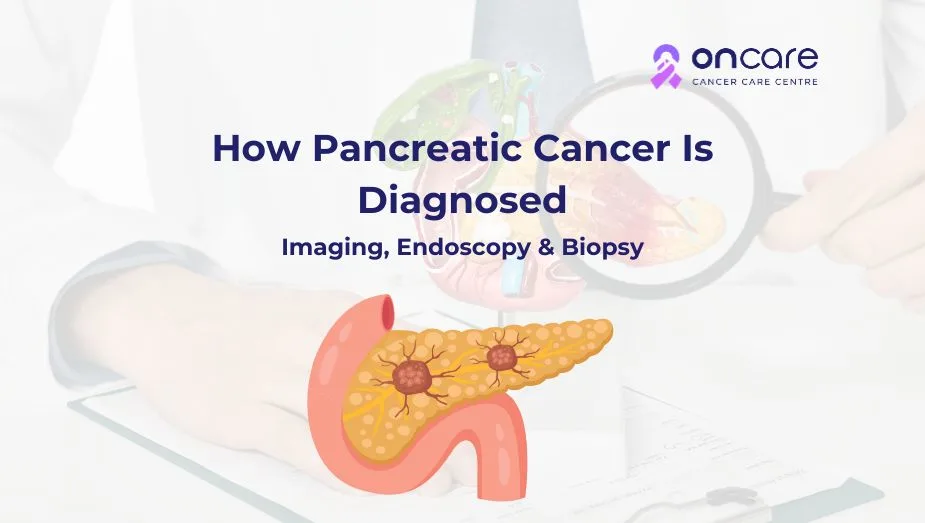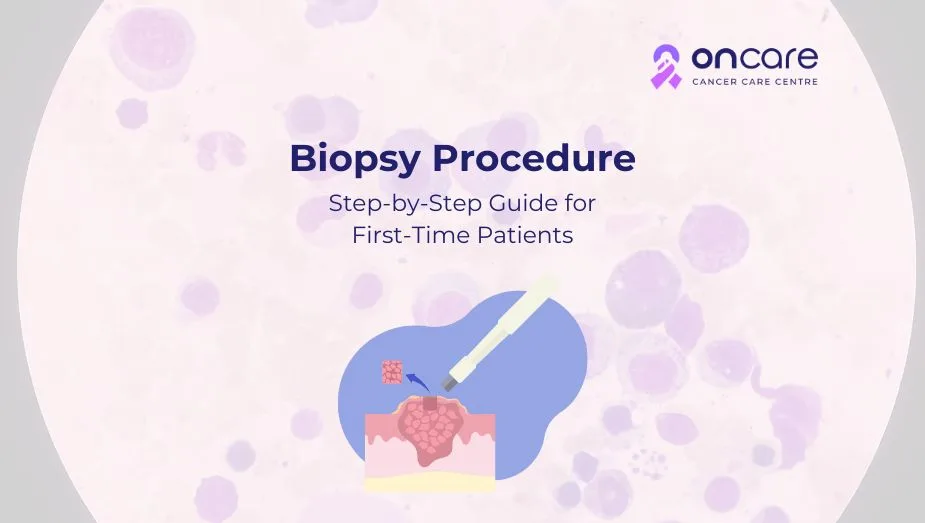Table of Contents
Biopsy Test for Cancer: Why It’s Done and How It Helps in Diagnosis

Cancer is one of the most complex and daunting diseases that one can be diagnosed with. It often requires a combination of treatment approaches to diagnose, manage, and treat cancer in patients. When oncologists suspect cancer in patients, they might use various diagnostic tests. One of the most crucial procedures in confirming cancer disease is performing a biopsy test for cancer.
In this blog, we’ll discover more about how biopsy helps in cancer diagnosis, and we’ll explore more about how these tests are performed and how they aid in diagnosing cancer.
What is a Biopsy?
Biopsy is a significant medical procedure in which a small sample of a tissue is taken out of the suspected patient’s body for further examination under a microscope. This sample is often analyzed by a pathologist to confirm the presence of cancer cells or other abnormalities in the collected tissue sample.
A biopsy is performed on nearly any part of the body where cancer is suspected, such as the breast, lungs, colon, liver, or skin.
Different types of biopsies
There are different types of biopsies performed to collect suspected cancer tissues and fluid, and they are performed in different ways.
Here are some of the types of biopsies, including:
- Bone marrow biopsy
- Cone biopsy
- Excisional biopsy or incisional biopsy
- Liquid biopsy
- Needle biopsy
- Punch biopsy
- Sentinel node biopsy
- Shave biopsy
Why is a biopsy performed?
A biopsy is performed to diagnose various health conditions, especially cancer, by collecting and analyzing tissue or cell samples under a microscope. It allows healthcare providers to determine if there’s any suspicious lump or abnormality, whether it could be cancerous or not. It helps to identify the type and cause of cancer and the stage and extent of growth. Additionally, planning which treatment is an effective treatment for the cancer.
How does a biopsy help in cancer diagnosis?
A biopsy generally aids cancer diagnosis by simply removing and examining tissue samples under a microscope. Performing a biopsy offers a clear insight to the healthcare provider into whether there are any cancer cells present or not. It also helps to identify the type of cancer and the cancer grade.
It confirms the cancer cells
Performing a biopsy helps to determine the tissue under a microscope to confirm if any cancer cells are present, differentiating between cancerous (malignant) and non-cancerous (benign) tumors.
It identifies the cancer type
Performing biopsy in a suspected patient often reveals the type of cancer like adenocarcinoma, which helps to determine the treatment options available for the patients.
It assesses cancer’s aggressiveness
A biopsy provides more clear insight into the cancer’s aggressiveness, which allows the medical team to predict its potential behavior.
It guides treatment options
Biopsy test results are crucial for your further cancer treatment. It helps to select the most appropriate and effective treatment plan.
It helps with cancer staging
Performing biopsies often provide cancer staging, which is the process of determining the extent of cancer’s spread.
Types of cancer that requires biopsy
Biopsies are crucial for diagnosing many types of cancer in a suspected patients,
including:
- Breast cancer: A biopsy is essential to confirm the presence of cancer cells in a suspicious lump or abnormality found on an imaging test.
- Lung cancer: A biopsy can often be used to identify any specific types of lung cancer, including adenocarcinoma or non-small cell lung cancer, which is essential to determine the appropriate treatment.
- Colon cancer: A biopsy may be performed to detect any types of polyps or tumors developed in the colon, allowing for timely removal of precancerous growths before they become malignant tumors.
- Skin cancer: There are different types of skin biopsies, like shave biopsies, punch biopsies, or excisional biopsies, which are generally used to remove tissue and determine if the tumor growth is cancerous or not and how deeply it has penetrated the skin.
- Prostate cancer: A biopsy is often performed on the prostate gland to provide information about the cancer’s stage, growth rate, and other features to guide the best treatment approach.
What’s to expect during Biopsy process
If you are advised to undergo a biopsy procedure, you might feel intimidated, but they are helpful for your timely disease diagnosis and starting early treatments.
Here’s what you can generally expect during the process:
Preparation: Your healthcare provider might ask you to do fasting (stop eating and drinking) or follow specific diet instructions, mainly depending on the type of biopsy and the type of anesthesia used in the procedure.
Biopsy Procedure: The biopsy procedure also performs anaesthesia which is common for numbing the entire area where the tissue is removed.
Here’s two common biopsy procedures:
- Needle biopsy: In this procedure, the doctor will use a needle into the suspicious area of cancer and remove a small sample.
- Surgical biopsy: In this case, a surgical biopsy procedure a tissue will be removed surgically under surgical anesthesia.
Recovery: Most biopsies have minimal recovery time; after taking some rest, you can go back home the same day. In some patients, soreness and bruising might appear at the site of biopsy, but these symptoms will improve quickly.
Results: Once the sample tissue is taken, they will then be sent to a lab, where a pathologist will examine the tissue under a microscope. These results will typically take several days to a week; your medical team will follow up with you to discuss the findings.
Consult Today
A biopsy test is a vital test used to diagnose and treat cancer. This type of diagnostic method allows the medical team to determine whether the tumor is cancerous or to identify the type of cancer and its characteristics, like how aggressive it can become. Biopsy results are often combined with more tests and scans, with doctors recommending the most effective treatment plan, giving patients the best opportunity to get effective treatment outcomes.
At Oncare, we offer premium quality cancer treatments, including advanced cancer surgeries at affordable price ranges with an experienced cancer specialist consultation.
If you or any loved ones of yours are diagnosed with cancer, then visit Oncare Cancer Center and book an appointment with our experienced cancer specialist today, Get an estimated cost of your cancer treatment today!
Frequently Asked Questions
There are several types of biopsies are used for cancer diagnosis, including:
- Bone marrow biopsy
- Cone biopsy
- Excisional biopsy
- Incisional biopsy
- Liquid biopsy
- Needle biopsy
- Punch biopsy
- Sentinel node biopsy
- Shave biopsy
The complications of biopsy are comparatively rare, it can happen. Depending on the biopsy procedure, complications may include:
- Excessive bleeding
- Infection
- Scarring
Consult your doctor immediately if the biopsy site won’t stop bleeding or if you have a high level of fever.
Biopsies are also used to diagnose some other medical conditions, like:
- Inflammatory disorders
- Infections like tuberculosis
- Immune disorders, such as chronic pancreatitis
- Peptic ulcer disease
- Endometriasis
Your medical team will explain the biopsy procedure they will use, including whether you may feel awake or under anesthesia. They would also review the following information. These may include:
- Your medical team will inquire about the medications you are taking
- Whether you have any allergies
- Current health conditions
- Whether you are pregnant or not
Book an Appointment
Related Blogs

How Doctors Confirm a Cancer Diagnosis: Tests, Scans & Biopsy Explained
Discover more about how doctors confirm a cancer diagnosis and the types of tests, scans, and biopsies, and the common types of biopsies used to confirm the diagnosis.

How Cervical Cancer Is Diagnosed: Pap Smear, HPV Test & Biopsy
Learn more about how cervical cancer is diagnosed using Pap smears, HPV tests, and cervical biopsies. Explore how each test is performed for early diagnosis!

How Pancreatic Cancer Is Diagnosed: Imaging, Endoscopy & Biopsy
Discover more about pancreatic cancer and how this cancer is diagnosed, types of diagnostic methods used, imaging tests, endoscopy, biopsy, and much more!

Lung Cancer Diagnosis: CT Scan, Biopsy, and Other Tests Explained
Discover more about lung cancer and its symptoms and risk factors, and what the diagnostic methods used for lung cancer are: CT scans, biopsies, and other tests.

Biopsy Test Price: What You Need to Know Before Booking
Discover more about the average biopsy test price and the factors influencing the average cost of a biopsy, and why you should choose Oncare for your biopsy tests!

Biopsy Procedure: Step-by-Step Guide for First-Time Patients
Discover more about the biopsy procedure, types of biopsy, a step-by-step guide to the biopsy procedures, post-procedure care, and tips for first-time patients.

Breast Biopsy: What It Is and Why It’s Done
Discover more about what a breast biopsy is, the need for a breast biopsy test and its types, what to expect before and after the procedure, and its risk factors!

Can a Biopsy Spread Cancer? Separating Myths from Facts
Discover more about biopsy, types of biopsy, whether biopsy can spread cancer, some major myths and misconceptions about cancer biopsies, and its hidden facts!

